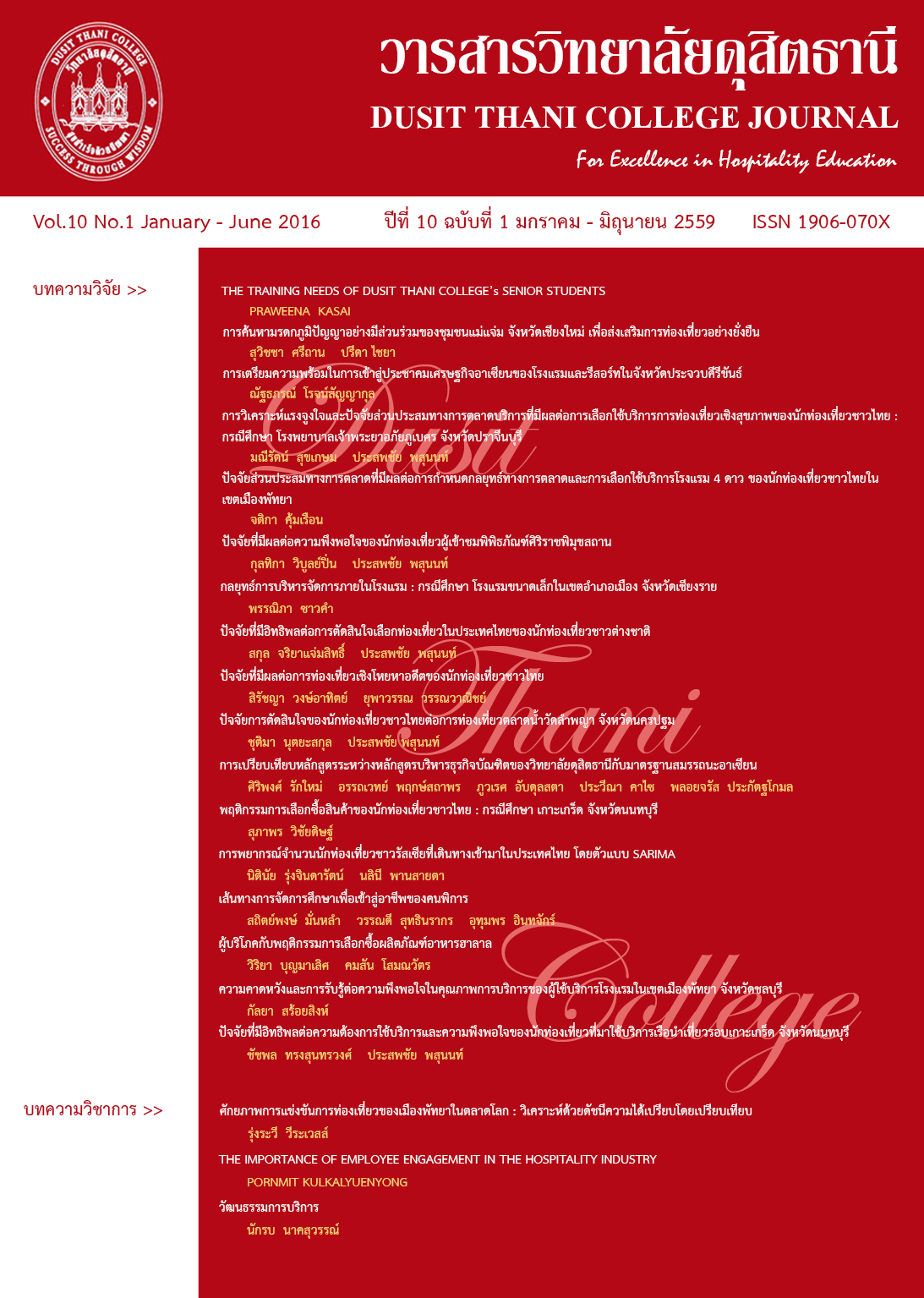FACTORS AFFECTING THAI TOURISTS’ DECISION MAKING IN NOSTALGIA TOURISM
Main Article Content
Abstract
The purposes of this research were to study the behavior and factors affecting Thai tourists’ decision making in Nostalgia Tourism including the differences between personal characteristics and factors affecting Thai tourists’ decision making in Nostalgia Tourism and the relationship between personal characteristics and tourists’ behavior. Data were gathered by using questionnaires from 402 Thai tourists who had visited 3 tourist sites such as Plearnwan Retro Market, Hua Hin Samphannam Floating Market ,and Raruk Hua Hin. Quota selection and convenience selection were used. The statistics for data analysis were percentage, mean, standard deviation, t-test, one-way ANOVA, and chi-square.
The results of this study were found that most samples traveled during weekend, on their first time of travelling, learned about Nostalgia Tourism from family/friend. Their transportations were private cars. Most of them came with their family/relatives. The main purposes of touring were traveling and recreation. The expenditure for travelling was about 1,000 baht. They tended to come back here again for sure and promised to introduce more people to join Nostalgia Tourism. Overall, tourists rated moderate satisfaction in Nostalgia Tourism.
Thai tourists’ overall opinions about the importance of 7 factors influencing their decision making in Nostalgia Tourism were at high level. The factors were divided into two groups as follows: Group 1 was important at high level, including facility, infrastructure, emotions and feelings, and tourism resources. Group 2 was important at rather high level, including security, advertising and public relations, and learning, respectively.
Hypothesis test results were found that Thai tourists with different education levels and occupation had different opinions regarding factors affecting their decisions making in Nostalgia Tourism. Moreover, Age, status, occupation, monthly income, and education levels of Thai tourists were correlated with tourist’ behavior with statistical significance at .05 level.
Article Details
Article Screening Policy
- All research and academic articles to be published must be considered and screened by three peer reviews in the relevant field / article.
- All articles, texts, illustrations and tables published in the journal are the personal opinions of the authors. Editors don't always have to agree. And no responsibility whatsoever is the sole responsibility of the author.
- The articles to be published must never be published. Where did you first publish? And not in the consideration of other journals If the audit found that there has been a duplicate publication It is the sole responsibility of the author.
- Any article that the reader sees as being plagiarized or impersonated without reference. Or mislead the work of the author Please let the journal editor know it will be your greatest blessing.
References
เจษฎารัตน์ กล่ำศรี และวรินทรา ศิริสุทธิกุล. (2557). “ความพึงพอใจต่อการท่องเที่ยวเชิงถวิลหาอดีตของนักท่องเที่ยวชาวไทยที่ หัวหิน.” บริหารธุรกิจศรีนครินทรวิโรฒ 5, 2 (กรกฎาคม-ธันวาคม 2557) : 114-131.
ชาตรี ประกิตนนทการ. “Retro marketในกระแสNostalgia Tourism.” (ออนไลน์). เข้าถึงได้จาก :
http://www.etatjournal.com/web/menu-read-web-etatjournal/menu-2013/menu-2013-apr- jun/513-22556-retro-market. วันที่เข้าถึง : 12 กย 2557.
บุญเลิศ จิตตั้งวัฒนา. (2548). อุตสาหกรรมการท่องเที่ยว. กรุงเทพฯ : ศูนย์วิชาการท่องเที่ยวแห่งประเทศไทย.
พัฒนา กิติอาษา. (2546). มานุษยวิทยากับการศึกษาปรากฏการณ์โหยหาอดีตในสังคมไทยร่วมสมัย. กรุงเทพฯ : ศูนย์มานุษยวิทยา สิรินธร (องค์การมหาชน).
พีรชัย กุลชัย และกัลยาณี กุลชัย. (2548). “ปัจจัยที่มีความสัมพันธ์กับการท่องเที่ยวเชิงเกษตร.” เรื่องเต็มการประชุมทางวิชาการของมหาวิทยาลัยเกษตรศาสตร์ ครั้งที่ 43 (กุมภาพันธ์ 2548) : 309-315.
ยุบล เบ็ญจรงค์กิจ. (2542). การวิเคราะห์ผู้รับสาร. กรุงเทพฯ: คณะนิเทศศาสตร์ จุฬาลงกรณ์มหาวิทยาลัย.
ศรินยา จันทร์ประโคน.(2553). “ปัจจัยที่มีอิทธิพลในการตัดสินใจเลือกท่องเที่ยวศิลปวัฒนธรรมขอมโบราณ.” วิทยานิพนธ์ปริญญามหาบัณฑิต สาขาบริหารธุรกิจ มหาวิทยาลัยขอนแก่น.
ศิริ ฮามสุโพธิ์.(2543). สังคมวิทยาการท่องเที่ยว. กรุงเทพฯ : โอเดียนสโตร์.
ศูนย์สารสนเทศยุทธศาสตร์ภาครัฐ สำนักงานสถิติแห่งชาติ. “Tourism Hub โอกาสทองของไทย.” (ออนไลน์) เข้าถึงได้จาก: http://www.tourismkm-asean.org/wp-content/pdf/SWOT/tourism_hub.pdf10. วันที่เข้าถึง 10 พฤศจิกายน 2557
สำนักงานตรวจคนเข้าเมืองและกรมการท่องเที่ยว. “บทที่ 6 การตลาดการท่องเที่ยว.” (ออนไลน์). เข้าถึงได้จาก :http://www.masterplan.andamanecotourism.com. วันที่เข้าถึง 10 พฤศจิกายน 2557.
องค์การบริหารการพัฒนาพื้นที่พิเศษเพื่อการท่องเที่ยวอย่างยั่งยืน. “เปิดข้อมูล WTO เผยกระแสย้อนยุคยังมาแรง.” โพสต์ทูเดย์. (11 กันยายน 2556) : A2.
อนุชิต บุญวิทย์. (2548). “พฤติกรรมการท่องเที่ยวและปัจจัยส่วนบุคคลที่มีความสัมพันธ์กับการท่องเที่ยวสวนสัตว์เปิดเขาเขียว จังหวัดชลบุรี.” สารนิพนธ์เศรษฐศาสตรมหาบัณฑิตมหาวิทยาลัยเกษตรศาสตร์.
Cochran, W.G. (1977). Sampling techniques. United States of America: John Wiley & sons, Inc.
Lowenthel, David. (1985). The past is a foreign country. Cambridge: Cambridge University Press.
Niemelä, T. (2010). “ Motivation Factors in Dark Tourism Case: House of Terror.” Bachelor’s thesis, The Faculty of Tourism and Hospitality Degree Programme in Tourism and Hospitality Management Nature and Soft Adventure Tourism, Lahti University of Applied Sciences.
Negrusa, A. and and Y. Medet. (2012). “Cultural Tourism Motivation-The Case of Romanian Youths.” Annals of Faculty of Economics 1 : 548-553.


